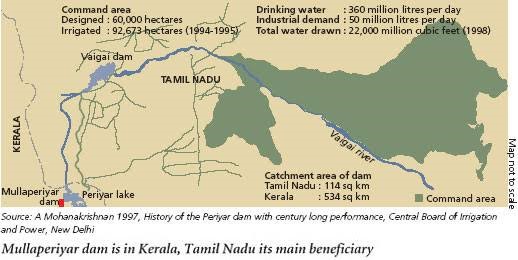[ad_1]
GS Paper 2:
Topics Covered: Separation of powers between various organs dispute redressal mechanisms and institutions.
Context:
The Kerala government has withdrawn its decision granting permission to Tamil Nadu for felling 15 trees downstream the Baby Dam at Mullaperiyar reservoir as part of efforts to strengthen the structure. The state government said that action will be taken against the officials who had sanctioned the move.

The present issue:
Please note that both the states are at loggerheads over the stability of the structure, with Kerala demanding that a new dam must be constructed and Tamil Nadu saying that a new structure is not needed. Also, Kerala has been against increasing water levels at the dam, citing structural stability.
Background:
Last month, the Supreme Court directed the Supervisory Committee to take an immediate and firm decision on the maximum water level that can be maintained at Mullaperiyar dam, amid torrential rain in Kerala.
- The SC constituted a permanent Supervisory Committee in 2014 to oversee all the issues concerning Mullaperiyar dam. The dam is a source of friction between Tamil Nadu and Kerala.

Issue surrounding water level at the reservoir?
- Kerala said the water level should not go above 139 feet, the same as what the court had ordered on August 24, 2018, when the State was hit by floods. It is because the lives of 50 lakh people would be in danger if the water level in the dam is raised.
- However, Tamil Nadu objected to this decision citing the Supreme Court judgments of 2006 and 2014, which fixed the maximum water level at 142 feet.
Mullaperiyar Dam– what you need to know?
Although the dam is located in Kerala, it is operated by Tamil Nadu following an 1886 lease indenture for 999 years (the Periyar Lake Lease Agreement) that was signed between the Maharaja of Travancore and the Secretary of State for India for the Periyar Irrigation works.
- Constructed between 1887 and 1895, the dam redirected the river to flow towards the Bay of Bengal, instead of the Arabian Sea and provide water to the arid rain region of Madurai in Madras Presidency.
- The dam is located on the confluence of the Mullayar and Periyar rivers inKerala’s Idukki district.
What does Tamil Nadu say?
Tamil Nadu claims that although it has undertaken measures to strengthen the dam, the Kerala government has blocked any attempt to raise the reservoir water level – resulting in losses for Madurai farmers.
Kerala’s arguments:
Kerala, however, highlights fears of devastation by residents living downstream in the earthquake-prone district of Idukki.
Scientists have argued that if there is an earthquake in the region measuring above six on the Richter scale, the lives of over three million people will come under grave danger.

Insta Curious:
What is the rule curve?
The ‘rule curve’ in a dam decides the fluctuating storage levels in a reservoir. The gate opening schedule of a dam is based on the ‘rule curve’. It is part of the “core safety” mechanism in a dam.
InstaLinks:
Prelims Link:
- Locations of Mullayar and Periyar rivers.
- Location of Mullaperiyar dam?
- Who manages the dam?
- About the 1886 Periyar Lake Lease Agreement.
- About the Interstate River Water Disputes Act, 1956 (IRWD Act).
Mains Link:
Examine why the Mullaperiyar dam issue has become bone of contention between Tamil Nadu and Kerala. Examine if the union government can help resolve this issue.
Sources: the Hindu.
[ad_2]

